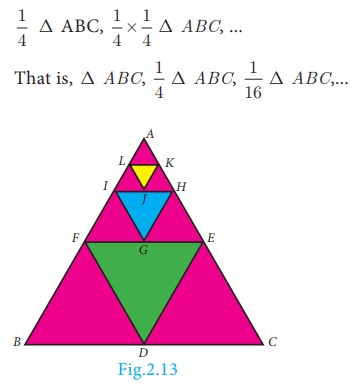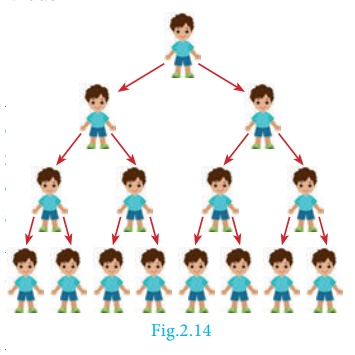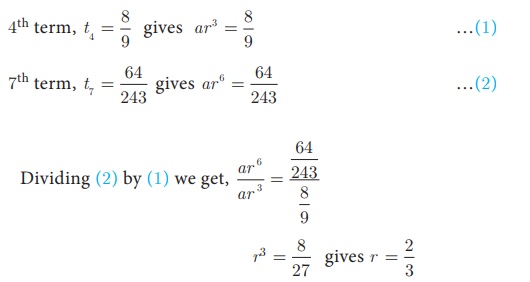Definition, General form, term, Example, Solution | Mathematics - Geometric Progression | 10th Mathematics : UNIT 2 : Numbers and Sequences
Chapter: 10th Mathematics : UNIT 2 : Numbers and Sequences
Geometric Progression
Geometric
Progression
In the diagram given in
Fig.2.13, ΔDEF is formed by joining the mid points of the sides AB, BC
and CA of ΔABC. Then the size of the triangle ΔDEF is
exactly one-fourth of the size of ΔABC. Similarly ΔGHI is also
one-fourth of ΔFDE and so on. In general, the successive areas are
one-fourth of the previous areas.
The area of these
triangles are D ABC,

In this case, we see
that beginning with ΔABC, we see that the successive triangles are
formed whose areas are precisely
one-fourth the area of the previous triangle. So, each term is obtained by
multiplying 1/4 to the previous term.

As another case, let us
consider that a viral disease is spreading in a way such that at any stage two
new persons get affected from an affected person. At first stage, one person is
affected, at second stage two persons are affected and is spreading to four
persons and so on. Then, number of persons affected at each stage are 1, 2, 4,
8, ... where except the first term, each term is precisely twice the previous
term.
From the above examples,
it is clear that each term is got by multiplying a fixed number to the
preceding number.
This idea leads us to
the concept of Geometric Progression.
Definition
A Geometric Progression is a sequence in which each term is obtained by multiplying a fixed non-zero number to the preceding term except the first term. The fixed number is called common ratio. The common ratio is usually denoted by r.
1. General form of Geometric Progression
Let a and r
≠ 0 be real numbers. Then the numbers of the form a , ar , ar2
, ... arn-1... is called a Geometric Progression. The number ‘a’
is called the first term and number ‘r’ is called the common ratio.
We note that beginning
with first term a, each term is obtained by multiplied with the common
ratio ‘r’ to give ar , ar 2 ,ar 3,...
2. General term of Geometric Progression
We try to find a formula
for nth term or general term of Geometric Progression (G.P.)
whose terms are in the common ratio.
a , ar , ar2
,..., arn-1, ... where a is the
first term and ‘r’ is the common ratio. Let tn be
the nth term of the G.P.
Then
t1 = a = a
× r0 = a ×r1−1
t2 = t1
× r = a × r = a × r2−1
t3 = t2
× r = ar × r = ar2 = ar3−1
: :
tn = tn
−1 × r = arn −2 × r = arn −2+1 = ar n−1
Thus, the general term or nth term of a G.P. is tn = arn-1
Note
If we consider the
ratio of successive terms of the G.P. then we have

Thus, the ratio between any two consecutive terms of the Geometric Progression is always constant and that constant is the common ratio of the given Progression.
Example 2.40
Which of the following
sequences form a Geometric Progression?
(i) 7, 14, 21, 28, …
(ii) 1/ 2 , 1, 2, 4, ...
(ii) 5, 25, 50, 75, …
Solution
To check if a given
sequence form a G.P. we have to see if the ratio between successive
terms are equal.
(i) 7, 14, 21, 28, …

Since the ratios between
successive terms are not equal, the sequence 7, 14, 21, 28, … is not a
Geometric Progression.
(ii)

Here the ratios between successive terms are equal. Therefore the sequence 1/2 , 1, 2, 4, ... is a Geometric Progression with common ratio r= 2.
(iii) 5, 25, 50, 75,...

Since the ratios between
successive terms are not equal , the sequence 5, 25, 50, 75,... is not a
Geometric Progression.
Example 2.41
Find the geometric
progression whose first term and common ratios are given by
(i)
a = −7 , r = 6
(ii)
a = 256 , r = 0.5
Solution
(i) The general form of
Geometric progression is a, ar, ar2 ,.. .
a = −7 , ar = −7 × 6 = −42 , ar 2
= −7 × 62 = −252
(ii) The general form of
Geometric progression is a, ar, ar2 ,...
a = 256 ,
ar = 256 × 0.5 = 128 , ar 2
= 256 ×(0.5)2 = 64
Therefore the required Geometric progression is 256,128, 64,....
Example 2.42
Find the 8th term of the G.P. 9, 3, 1,…
Solution
To find the 8th term we have to use the nth term formula tn = arn−1
First term a = 9
, common ratio r = 

Therefore the 8th
term of the G.P. is 1/243
Example 2.43
In a Geometric
progression, the 4th term is 8/9 and the 7th term is 64/243. Find the
Geometric Progression.
Solution

Substituting the value
of r in (1), we get a × [2/3]3
= 8/9 ⇒
a = 3
Therefore the Geometric
Progression is a, ar, ar2 , … That is, 3, 2, 4/3,…..
Note
·
When the product of three consecutive terms of a G.P. are given,
we can take the three terms as a/r , a, ar.
·
When the products of four consecutive terms are given for a G.P.
then we can take the four terms as a/r3 , a/r
, ar, ar 3 .
·
When each term of a Geometric Progression is multiplied or
divided by a non– zero constant then the resulting sequence is also a
Geometric Progression.
Example 2.44
The product of three
consecutive terms of a Geometric Progression is 343 and their sum is 91/3.
Find the three terms.
Solution
Since the product of 3 consecutive terms is
given.
we can take them as a/r,
a , ar .
Product of the terms =
343

Sum of the terms = 91/3

3 + 3r + 3r2
= 13r gives 3r2
− 10r + 3 = 0
(3r - 1)(r
- 3) = 0 gives r = 3 or r
= 1/3
If a = 7, r
= 3 then the three terms are 7/3, 7, 21.
If a = 7 , r = 1/3 then the three terms are 21, 7, 7/3.
Condition for three numbers to be in G.P.
If a, b,
c are in G.P. then b = ar , c
= ar 2 . So ac = a ×ar 2 = (ar)2 = b2 .Thus b2 = ac
Similarly,
if b2 = ac , then
b/a = c/b . . So a, b, c
are in G.P.
Thus
three non-zero numbers a, b, c
are in G.P. if and only if b2
= ac .
Example 2.45
The present value of a
machine is ₹40,000 and its value depreciates each year by 10%. Find the estimated value of the
machine in the 6th year.
Solution
The value of the machine
at present is ₹40,000. Since it is depreciated at the rate of 10% after one year
the value of the machine is 90% of the initial value.
That is the value of the
machine at the end of the first year is 40, 000 × (90/100)
After two years, the
value of the machine is 90% of the value in the first year.
Value of the machine at
the end of the 2nd year is 40,000× [90/100]2
Continuing this way, the
value of the machine depreciates in the following way as

This sequence is in the
form of G.P. with first term 40,000 and common ratio 90/100. For finding the
value of the machine at the end of 5th year (i.e. in 6th
year), we need to find the sixth term of this G.P.
Thus, n=6, a=40,000,
r = 90/100

Therefore the value of
the machine in 6th year = ₹23619.60
Related Topics